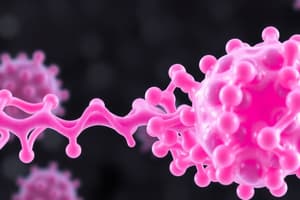Podcast
Questions and Answers
Which apolipoprotein acts as a receptor for the HDL receptor?
Which apolipoprotein acts as a receptor for the HDL receptor?
- Apo C-II
- Apo E
- Apo B-100
- Apo A-I (correct)
What is the primary function of chylomicrons?
What is the primary function of chylomicrons?
- Transport dietary lipids from the intestine (correct)
- Facilitate cholesterol ester transfer
- Transport endogenous lipids from the liver
- Act as enzyme inhibitors in lipid metabolism
Which apolipoprotein is mainly involved as an enzyme inhibitor for lipoprotein lipase?
Which apolipoprotein is mainly involved as an enzyme inhibitor for lipoprotein lipase?
- Apo C-III (correct)
- Apo A-II
- Apo B-48
- Apo C-I
What best describes the half-life of chylomicrons?
What best describes the half-life of chylomicrons?
Which of the following statements about Intermediate Density Lipoproteins (IDL) is true?
Which of the following statements about Intermediate Density Lipoproteins (IDL) is true?
What is the primary role of apolipoproteins in lipoproteins?
What is the primary role of apolipoproteins in lipoproteins?
Which lipoprotein type primarily transports triacylglycerols?
Which lipoprotein type primarily transports triacylglycerols?
How does the density of a lipoprotein change as its protein content increases?
How does the density of a lipoprotein change as its protein content increases?
What is the predominant lipid found in low-density lipoproteins (LDL)?
What is the predominant lipid found in low-density lipoproteins (LDL)?
Identify the correct classification of lipoproteins based on their density from lowest to highest.
Identify the correct classification of lipoproteins based on their density from lowest to highest.
What distinguishes apo B48 from apo B100?
What distinguishes apo B48 from apo B100?
Which lipoprotein is synthesized in the liver and has a similar lipid composition to LDL?
Which lipoprotein is synthesized in the liver and has a similar lipid composition to LDL?
What percentage of total plasma lipid does cholesterol represent?
What percentage of total plasma lipid does cholesterol represent?
Flashcards
Apolipoprotein
Apolipoprotein
A protein component of lipoproteins that helps them bind to receptors on cells, enabling the uptake of lipids.
Chylomicron
Chylomicron
A type of lipoprotein that carries lipids from the intestines to the body's tissues after a meal.
Very Low-Density Lipoprotein (VLDL)
Very Low-Density Lipoprotein (VLDL)
A type of lipoprotein that carries lipids synthesized by the liver to the body's tissues.
Lipoprotein Lipase (LPL)
Lipoprotein Lipase (LPL)
Signup and view all the flashcards
Intermediate Density Lipoprotein (IDL)
Intermediate Density Lipoprotein (IDL)
Signup and view all the flashcards
Lipoproteins
Lipoproteins
Signup and view all the flashcards
Lipoprotein Classes
Lipoprotein Classes
Signup and view all the flashcards
Low-Density Lipoproteins (LDL)
Low-Density Lipoproteins (LDL)
Signup and view all the flashcards
High-Density Lipoproteins (HDL)
High-Density Lipoproteins (HDL)
Signup and view all the flashcards
Lipoprotein (a) [Lpa]
Lipoprotein (a) [Lpa]
Signup and view all the flashcards
Study Notes
Lipid Transport
- Lipids are insoluble in water, so they associate with proteins forming water-soluble lipoproteins
- The protein part of lipoproteins is called apolipoprotein
- Lipoproteins transport lipids between tissues
- Total plasma lipid is 400-600 mg/dL, including triacylglycerol (20%), phospholipids (30%), cholesterol (40%), and unesterified fatty acids
- Lipoproteins consist of:
- A lipid core of nonpolar TAG and cholesterol esters
- A surface layer of phospholipids and cholesterol
- Proteins, called apolipoproteins (APOs)
- APOs range from 1% in chylomicrons to 60% in some HDLs
- Some APOs are peripheral, while others are integral
Classification of Lipoproteins
- Lipoprotein density increases with the protein component
- Lipoproteins can be separated by ultracentrifugation and electrophoresis
- Chylomicrons
- Very low-density lipoproteins (VLDL)
- Intermediate-density lipoproteins (IDL)
- Low-density lipoproteins (LDL)
- High-density lipoproteins (HDL)
- Lipoprotein (a) [Lp(a)]: similar lipid composition to LDL; competes with plasminogen for tissue plasminogen receptors
- Lipids in lipoproteins include triacylglycerol (TAG), phospholipids (PL), cholesterol, cholesterol esters, and free fatty acids (FFAs)
- TAG is predominant in chylomicrons and VLDL. Cholesterol is predominant in LDL, and phospholipids in HDL
Apo-lipoproteins (Apoproteins)
- Apoproteins are the protein part of lipoproteins, mainly synthesized in the liver and small intestine
- Five major classes (from A to E) are known
- Apo B exists in two forms: Apo B100 (in LDL) and Apo B48 (in chylomicrons)
- Apo(a) is present in Lp(a) with Apo B100 and has a high carbohydrate content
- Functions of Apoproteins
- Increase lipid solubility in plasma
- Enhance lipoprotein stability
- Act as ligands for interaction with lipoprotein receptors, regulating tissue uptake.
- Apo B-100 and Apo E bind to LDL receptors
- Apo E binds to remnant receptors
- Apo A-I binds to HDL receptors
Some Apolipoproteins as Enzyme Activators or Inhibitors
- Some APOs act as enzyme activators or inhibitors
- Activators:
- Apo C-II activates lipoprotein lipase
- Apo A-I activates lecithin-cholesterol acyltransferase (LCAT)
- Inhibitors:
- Apo A-II and Apo C-III inhibit lipoprotein lipase
- Apo C-I inhibits cholesteryl ester transfer protein
Metabolism of Chylomicrons
- Site of synthesis: intestinal mucosa
- Function: transport dietary lipids to peripheral tissues
- Structure:
- 98% lipids (mainly triacylglycerol)
- 1-2% proteins (including apo B-48, apo E, and apo C-II)
- Half-life: approximately 1 hour
Metabolism of Very-Low-Density Lipoproteins (VLDL)
- Site of synthesis: liver
- Function: transport endogenously synthesized lipids from the liver to peripheral tissues
- Structure:
- Primarily triacylglycerol
- 10% proteins (including apo B-100, apo E, and apo C-II)
- Half-life: 1-3 hours
Formation of IDL (Intermediate-Density Lipoproteins)
- LpL activity reduces TAG by 70-90%, and Apo C, but not Apo E, leading to VLDL remnants (IDL)
- IDL contains less TAG and more cholesterol
- IDL fate:
- Taken up by the liver via LDL receptors (Apo B-100, E)
- Converted to LDL (mostly)
Studying That Suits You
Use AI to generate personalized quizzes and flashcards to suit your learning preferences.




